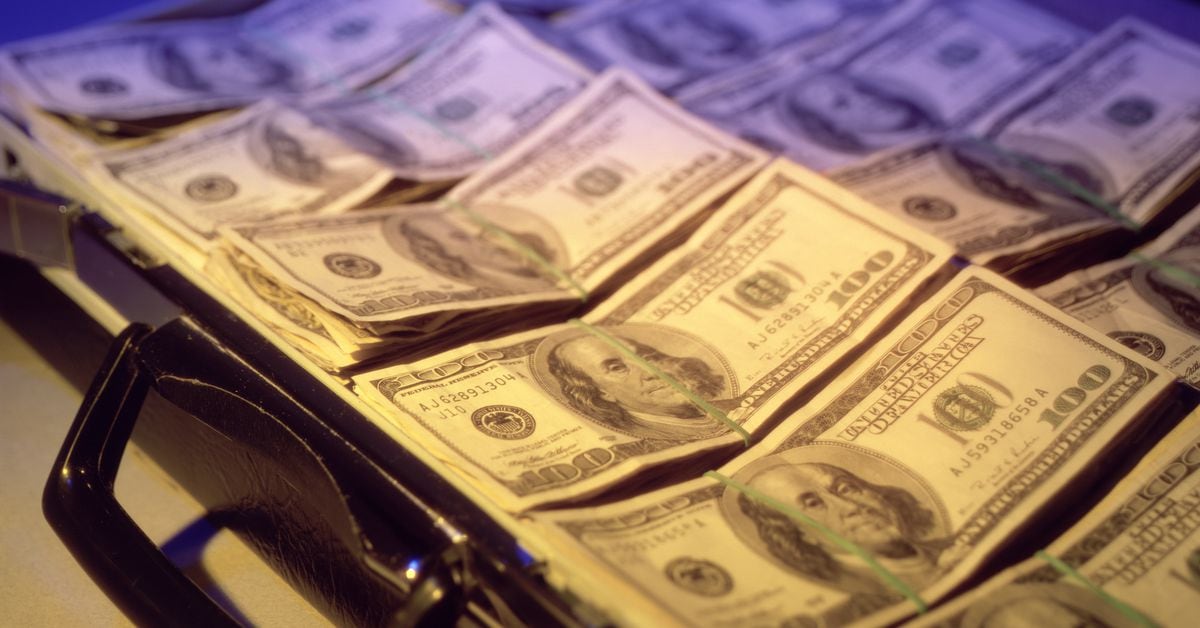
The European Union is in late-stage talks over how to implement new rules intended to curb dodgy behavior that uses virtual assets – but estimates of the share of crypto payments linked to financial crime vary wildly from 0.15% to a whopping 46% of transaction volumes.
There’s clearly a lot of illicit activity in the crypto world – of which some, like scams or hacks, are harmful to honest crypto users, while others might seem like a way of circumventing rules that were unfair in the first place, like government-imposed capital controls.
People in the crypto industry like to quote the figures on the lower end of the range, and on Friday, Binance’s CEO Changpeng “CZ” Zhao tweeted statistics to argue that crypto is safer than fiat.
But attempting to get a handle on the exact scale of unlawful virtual asset activity isn’t easy. It usually relies on identifying crypto addresses that appear suspect and totting up their trade volume – but illicit users generally prefer to hide in the shadows.
The result you get depends on how much certainty you want to have about who the illicit actors are online. When branding a wallet address as suspect, you might want to have a smoking gun that constitutes absolute proof, or be happy to accept something more probabilistic and speculative.
For regulators, judges and law enforcement, understanding the problem could prove crucial to determining whether new laws to force crypto users to identify themselves are needed or even lawful.
Yet there’s surprisingly little consensus on how big crypto crime is. Almost certainly, in dollar terms, it’s dwarfed by the real-life version. According to the U.N. Office on Drugs and Crime, money laundering through conventional finance is worth as much as $2 trillion, comparable to the total value of all the world’s crypto markets combined.
But regulators are worried not just about the overall volumes, but what they represent as a share of the crypto sector. They’ve noted how fast virtual assets are gaining popularity, and are thinking about what the scale of the problem might be in future, not just today.
In a recent speech that criticized the industry as akin to a lawless Wild West, the European Central Bank’s Fabio Panetta cited a wide range of figures for illicit crypto activity, ranging from under 1% to as much as half of all virtual transactions.
One reason for variation in figures is whether you look at, say, drug purchases as a share of crypto payments or compared to the overall market. People who acquire bitcoin (BTC) just to “HODL” aren’t doing anything wrong – but that means a greater proportion of those using it to buy something are likely to be engaging in illicit activity.
Which wallet?
But beyond the question of exactly what you’re counting, there’s also a question of how you’re counting these transactions – and that all depends on how you determine who the bad actors are.
Industry figures and academics such as CZ, or Georgetown Law’s Chris Brummer, often quote figures from blockchain specialists Chainalysis – which said in January that transactions involving illicit addresses represented just 0.15% of cryptocurrency transaction volumes last year.
But that approach leaves plenty of crimes unaccounted for, CoinDesk was told by Sean Foley, an associate professor of applied finance at Macquarie University in Australia.
Foley’s own paper, evocatively titled “Sex, Drugs, and Bitcoin,” was peer-reviewed and published in the Review of Financial Studies in 2019. It concluded that one-quarter of bitcoin users are involved in illegal activity, and that the $76 billion in illicit payments involving bitcoin represented 46% of the currency’s total transactions.
That’s a much higher estimate than others on the market – but Foley defended his methods in an interview with CoinDesk.
Chainalysis “are not necessarily very transparent in their approach,” he said. “They don’t really accurately document how they arrive at their numbers.”
“If Chainalysis only looked at Ross Ulbricht’s wallet that was seized by the FBI, but I look at all of his conduct through time. … I’m going to find a lot more,” he said, referring to the founder of the Silk Road marketplace who was sentenced to jail in 2015.
Rather than just looking at addresses known to be suspect, Foley looked at each users’ networks and behaviors, using statistical techniques that are also deployed in fields like medicine and nuclear safety.
While, say, using a mixer to stay anonymous isn’t a smoking gun proving bad behavior, he says that taken together, different indicators can give you a good view about whether someone is up to no good.
“If you look dodgy because you were predominantly interacting with dodgy people, and you look dodgy because you were using a lot of tumbling services, and there was a lot of activity when darknet marketplaces got seized … this gives us the ability to say with a much higher degree of confidence that these are likely illicit actors,” he said.
Too far?
Others warn Foley might have gone too far, unfairly tainting innocent crypto users by association.
“You have to be really careful with crime data and the associations that you make between wallets,” Kim Grauer, Chainalysis’ head of research, told CoinDesk. Chainalysis says that illicit wallets received $14 billion in 2021, a figure much lower than Foley’s.
“A lot of times people will just see money transacting between a crime wallet and another wallet and they’ll say, ‘hey, those must be connected,’” she said – citing examples such as when a single service managed millions of different addresses.
The “quirky” nature of blockchain means that “if you are not a crime investigator with blockchain experience, I would be a little bit skeptical of some of the definitive associations,” she said.
Chainalysis’ own data, in contrast to Foley’s, “is not extrapolated, it’s not statistically determined,” she said. “This is the real amount of transactions that are identified as illicit from a data set that’s the most powerful data set on cryptocurrency in the world.”
The Chainalysis figure still isn’t all encompassing, she acknowledged. It doesn’t include real-life crimes like street drug deals that then get laundered via bitcoin, nor gray areas like wash trading – the fake sales intended to push up market prices that appear to be becoming more common in the market for non-fungible tokens.
Scams can often only be identified after the rug is pulled, meaning the data for a given year can lag behind and needs to be updated. But, she said that an approach based on “hundreds of hundreds” of investigators sleuthing darknet forums looking for crime is “definitely, definitely fair.”
Too old?
A further wrinkle is how rapidly data ages in such a fast moving market. The data Foley used dates back to 2017 – a lifetime ago, in the crypto world – but, if anything, he thinks the problem has only increased since then.
He acknowledges illicit bitcoin volumes have probably fallen over time – but only because wrongdoers turned to less ostentatious alternatives, such as ZCash, Monero and Dash.
“There’s a lot of privacy technology that has been developed since the publication of our paper,” he said, and he believes that overall the criminal use of crypto “is not going down.”
“There’s still a ton of online marketplaces for darknet products, so I don’t think that’s gone away,” he said – and also cited the rise in industrial-scale ransomware like the $5 million 2021 hack of Colonial Pipeline.
Regulators unconvinced
The people who really need to be convinced are, of course, the Financial Action Task Force, the international body responsible for developing money laundering norms for conventional finance and the crypto sector – including the controversial travel rule that the EU is now trying to implement.
In a report published in July 2021, FATF noticed significant variations in estimates of illicit crypto trades both over time and among different analysts, such as Chainalysis, Elliptic and Merkle Science – which could be, Grauer said, because they look at a different universe of transactions or currencies.
Whatever the reason, FATF believes that the analysts’ estimates of the percentage of transactions that are unlawful, which range from 0.1% to 15.4%, are all too low.
“The data provided only relates to identified illicit transactions which the companies are able to identify, based on lists of known or suspected illicit addresses,” the FATF report said. Figures from the likes of Chainalysis should be “treated as the likely minimum,” it concluded.
Grauer also seems to concede that point – saying that her favored figure “is a floor for the amount of illicit activity.”
“We wouldn’t know how many [illicit actors] were missing,” she said. “You don’t know what you don’t know … if we knew about it, we would put it in our system.”
In the end, Foley and Grauer may have come up with different results because they have different aims. In the former case, it’s seeking to estimate the overall volumes linked to crime, and in the latter, identifying individual users who might be worth pursuing – something that requires a much higher burden of proof.
Methods like Foley’s are “certainly extremely useful,” Grauer said, but she warned that “results should not be relied on when it comes to identifying illicit wallets.”
“People use our data set to run full investigations, including putting people in jail,” she said – so she won’t blacklist someone lightly.
This matters for live policy. In March, the European Parliament voted to introduce new checks on the identities of those making even the smallest crypto payments – including, most controversially, when transactions are made with unhosted wallets that aren’t managed by a regulated exchange.
The idea – whose details still need to be finalized with national governments – is that law enforcement would then be able to more easily track crypto transactions that could be used to fund serious crimes, such as terrorism or child pornography. But the move met with a slew of opposition from industry players such as Coinbase (COIN), who said the bill could stifle innovation and harm privacy.
Laws that invade privacy more than they need to could get struck down, legal experts, such as Amsterdam University’s Thibaut Schrepel, told CoinDesk. That message seems to have gotten through to officials, such as the European Commission’s Gabriel Hugonnot, who has warned lawmakers that they would need to justify attempts to treat crypto differently from other kinds of financial transfers.
In considering whether the law is really needed, policymakers – and, eventually, judges – could be swayed by figures on the overall scale of the crypto crime problem, and by other features of crypto tech like the transparency of the network.
However imprecise the figures are, the kind of analysis possible on the blockchain is still much better than offline financial-crime stats, Grauer reckons.
“There is no equivalent number in the fiat world, because doing this type of research is just not possible,” she said. “Using U.S. dollars, how many drug dealers are there in the world? There’s never a number you’re going to get.”
But, ultimately, good policies come from good data – and it may be in short supply.



